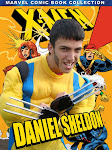Let me start by giving an overview of our film:
"Plead" is a gritty British courtroom drama, which follows the struggles of a young woman, Lzzie, aged 19, who has brutally murdered her abusive boyfriend of 3 years, Josh, aged 23. She pleads guilty to the charge of murder without considering the other factors involved.
It is the job of her lawyer, Arthur Windsor, to dig deep into her memories and those of her friends and relatives to reveal the hiddent ruth of this murder. THe film shows the courtcase and reflects on all the evens which may have lead up to the murder from the perspective of the Lawyer; this way the audience knows only as uch as the information presented in the investigation.
Inspiration for the plot
When discussing the plot of this film with Adam and Michael, I immediately associated this with the storyline of a court case in the BBC series Waterloo Road (Series 5), which follows a case where a teenager murders her father who has been abusing her mother in a similar manner to our protagonist.
This sereis targets a very similar audience (16-21 females) so I felt this is an appropriate example to refer to when finalising our plot.
Opening Sequence
The sequence opens with establishing shots of the suburban setting. We are then taken instantly to the actio, with Lizzie kneeling above Josh's brutally stabbed and blood covered body. She's breathing heavily taking her time to absorb the events which have only just occured. She is interrupted by a knock on the door from a concerned neighbour, Paul, who informs her that he has heard a "commotion" and desires to help; our protagonist, however turns him away.
Our film does not adhere perfectly to a typical narrative structure. However, Todorov's equilibrium-disequilibrium theory and Propp's theory of character roles were significant too.
Todorov's equilibrium-disequilibrium theory:
Although these roles are typical of a courtroom drama, we included an essence of ambiguity to Lizzie's character (is she villain or hero?), to retain audience interest.
Form
The task set was to create an opening sequence of a film, so it was important to follow a set format which would include the conventions of a title sequence. Earlier in the year, when studying TV Dramas we analysed many opening sequences and learnt that the conventions are:
- the opening sequence introduces characters and their relationships
- Sets up the rest of the film
- Includes titles which introduces the cast and crew
Our opening sequence clearly presents the characters and through the disturbing shot of the blood splattered photo, the audience immediately understands that they WERE in a loving relationship.
We recognised early on that audio is particularly useful in subtly creating tension and imposing a heart-stopping impact. For this we used the technique from The Dark Knight (2008, Nolan) and Paranormal Activity (2009, Peli) where audio is very quiet and goes through a crescendo over a long period of time till the sound is sickening and generally overwhelming with tension. We particularly used low rumble drones like in Paranormal Activity, although it is a different genre (horror) because we knew it was effective due to its realism.
Finally, we altered the hue and saturation in grading the footage to further intensify the drama. We attempted to desaturate the film to give the gritty British feel, however we boosted the reds to make the blood more vibrant. We also made the bedroom have a reddish hue, since this is where the murder just took place, representing the "heat" of the moment. In contrast, we included a slight blue hue over all footage outside the bedroom to accentuate a pristine, realistic and gritty feel to display to the audience that life still occurs as normal in the outside world.














0 comments:
Post a Comment